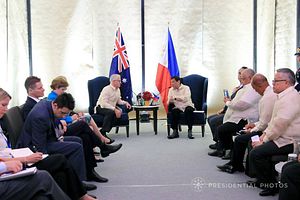Over the weekend, Australian Prime Minister Malcolm Turnbull was one of the list of foreign leaders that descended on the Philippines for this year’s round of meetings by the Association of Southeast Asian Nations (ASEAN), which Manila has been chairing. Turnbull’s visit, which included a summit meeting with Philippine President Rodrigo Duterte, put the recent activity we have seen in the Australia-Philippine defense relationship in the spotlight.
As I have noted before, Australia and the Philippines have long had a strong defense relationship (See: “New Australia Military Terror Aid for the Philippines?”). Security ties have included not just regular interactions like exchanges and exercises but capacity-building in areas ranging from maritime security to counterterrorism, assistance with respect to the peace process in the southern Philippines, and occasionally more advanced forms of training and assistance as Canberra is one of just two countries (the other being the United States) that has a formal visiting forces agreement (VFA) with Manila.
Though Duterte’s emergence had initially complicated ties, the siege by Islamic State-linked militants in the southern city of Marawi that erupted in May helped reinforce the importance of the bilateral defense relationship, with Australia offering various forms of support including AP-3C Orion military planes to help with surveillance (See: “Battle for Marawi Exposes Philippine Military’s Intelligence Crisis”). Over the past few months, Australia has begun to unveil more direct forms of military assistance, including the deployment of ADF troops for the Philippine military, and both sides have also been exploring other avenues for cooperation from intelligence-sharing to greater maritime security collaboration.
Turnbull’s visit to the Philippines was thus an opportunity to build on cooperation that has already been proceeding. As one example of this, in a development that did not make many headlines ahead of Turnbull’s trip but was nonetheless significant, the two navies kicked off the Combined Philippine Navy-Royal Australian Navy Maritime Security Engagement on November 10 that will last until early December.
According to Naval Forces Western Mindanao (NFWM), under whose area of responsibility (AOR) the engagement was conducted, activities included planning and coordination for the conduct of combined patrols around the AOR with respect to the Sulu Sea. As I have been noting in these pages, the Sulu-Sulawesi Seas in particular has become an area of interest for outside powers as greater collaboration among regional states takes shape, with the trilateral patrols by Malaysia, Indonesia, and the Philippines being a case in point (See: “A US-China Role in the Sulu Sea Trilateral Patrols?”).
Turnbull’s visit did place the defense aspect of bilateral ties even more in the spotlight. Security issues featured in his first-ever bilateral meeting with Duterte. Though few details were publicly disclosed, the two leaders discussed matters ranging from the South China Sea to terrorism to maritime security cooperation (See: “Will a China-ASEAN South China Sea Code of Conduct Really Matter?”).
In an indication of the significance of the defense realm of the relationship, Turnbull also paid a visit to the AFP’s headquarters in Camp Aguinaldo. There, he met with Philippine defense officials and witnessed a joint urban warfare demonstration by troops on both sides. Though the drill itself was quite basic – running about ten minutes, featuring about 20 Philippine and Australian troops, and focused around a counter improvised explosive device (counter-IED) scenario – the symbolism was an unmistakable.
In a further indicator of the breadth of Australia’s role in the Philippines, Turnbull also visited the new warehouse at the National Resource Operations Center of the Department of Social Welfare and Development (DSWD) in Pasay City. The construction of the warehouse, which just opened last year, was made possible with Australian assistance. There, Turnbull announced the delivery of AUD1.5 million worth of prepositioned relief supplies and associated funds to boost Manila’s response to humanitarian crises, including the Marawi crisis. Turnbull’s remark that Canberra would be committed to help Manila win the peace was not just a slogan for good headlines, but a genuine concern by regional states about the terror threat that persists post-Marawi and the work that remains to be done (See: “ASEAN’s Post-Marawi Islamic State Challenge”).































